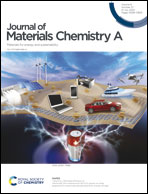Solution processable small molecules as efficient electron transport layers in organic optoelectronic devices†
Abstract
Organic semiconductor-based optoelectronic devices, such as organic solar cells (OSCs) and organic light-emitting diodes (OLEDs), have been investigated for solution-processable roll-to-roll electronic devices. However, for commercial applications, OSCs and OLEDs require highly efficient device performance and effective fabrication processing methods. To achieve this, this work reports the use of solution-processable quinoxaline–phosphine oxide based small molecules (QPSMs) as electron transport layers (ETLs) in OSCs and OLEDs. QPSMs can be dissolved in alcohol owing to the strong dipole moments within their molecular structures, thereby resulting in simple and effective processing during device fabrication. Moreover, QPSMs improve electron injection/extraction via the well-matched energy levels in both OSCs and OLEDs. In particular, optimized OSCs and OLEDs with ((4-(2,3-diphenylquinoxalin-5-yl)phenyl)diphenylphosphine oxide, QxTPPO1) show power conversion efficiency (PCE) of 16.83% in polymer donor : nonfullerene acceptor systems, PCE of 10.07% in polymer donor : fullerene acceptor systems, and external quantum efficiency of 5.00%, which are enhanced by approximately 23%, 19%, and 12%, respectively, compared to those of the reference devices, thereby exhibiting improved device stability.



 Please wait while we load your content...
Please wait while we load your content...